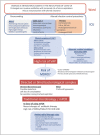How common is ventilator-associated pneumonia after coronavirus disease 2019?
- PMID: 35044973
- PMCID: PMC8900889
- DOI: 10.1097/QCO.0000000000000817
How common is ventilator-associated pneumonia after coronavirus disease 2019?
Abstract
Purpose of review: The first studies on COVID-19 patients with acute respiratory distress syndrome (ARDS) described a high rate of secondary bacterial ventilator-associated pneumonia (VAP). The specificity of VAP diagnoses in these patients are reviewed, including their actual rate.
Recent findings: Published studies described high rates of bacterial VAP among COVID-19 patients with ARDS, and these VAP episodes are usually severe and of specifically poor prognosis with high mortality. Indeed, Severe acute respiratory syndrome - coronavirus disease 19 (SARS-CoV2) infection elicits alterations that may explain a high risk of VAP. In addition, breaches in the aseptic management of patients might have occurred when the burden of care was heavy. In addition, VAP in these patients is more frequently suspected, and more often investigated with diagnostic tools based on molecular techniques.
Summary: VAP is frequented and of particularly poor prognosis in COVID-19 patients with ARDS. It can be explained by SARS-CoV-2 pathophysiology, and also breaches in the aseptic procedures. In addition, tools based on molecular techniques allow an early diagnosis and unmask VAP usually underdiagnosed by traditional culture-based methods. The impact of molecular technique-based diagnostics in improving antibacterial therapy and COVID-19 prognosis remain to be evaluated.
Copyright © 2022 Wolters Kluwer Health, Inc. All rights reserved.
Conflict of interest statement
Figures


References
-
- Rouzé A, Martin-Loeches I, Povoa P<ET-AL\>. coVAPid study Group. Relationship between SARS-CoV-2 infection and the incidence of ventilator-associated lower respiratory tract infections: a European multicenter cohort study. Intensive Care Med 2021; 47:188–198. - PMC - PubMed
-
An European multicenter retrospective cohort including 568 patients, comparing lower respiratory tract infections occurring in COVID-19, influenza and nonviral ARDS. The incidence was higher in SARS-CoV-2 infections (50.5 versus 30.3 and 25.3%, respectively). Multidrug-resistant pathogens were isolated in 23.3%.
Publication types
MeSH terms
Substances
LinkOut - more resources
Full Text Sources
Medical
Research Materials
Miscellaneous

